|
|
|
Sort Order |
|
|
|
Items / Page
|
|
|
|
|
|
|
| Srl | Item |
| 1 |
ID:
168667
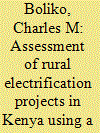

|
|
|
|
|
| Summary/Abstract |
This research is driven by the goal to develop human survivability studies, a solution oriented, trans-disciplinary academic approach for resolving multiple complex societal challenges. Given persisting poverty and inequality in rural areas of developing countries, as well as their vulnerability to the effects of climate change, there are high expectations that rural electrification using renewable energy can contribute to their sustainable development. We therefore use a sustainability framework to assess the contributions of four electrification projects in rural Kenya in ensuring the long-term well-being of local residents and future generations. Our results show that off-grid electrification projects run by the private sector were the better performers in the assessment. While more research is necessary to improve robustness, our preliminary policy recommendations are that Kenyan policy makers should provide further support to private sector-led off-grid solar electrification efforts.
|
|
|
|
|
|
|
|
|
|
|
|
|
|
|
|
| 2 |
ID:
166714


|
|
|
|
|
| Summary/Abstract |
While access to cleaner fuel is a sustainable development goal, the transition from traditional to modern fuel is yet to be achieved in India. This paper estimates fuel costs associated with such transitions and analyses the determinants of access to electricity for lighting and Liquified Petroleum Gas (LPG) for cooking. State-level regression models based on data from 61st (2004–05), 68th (2011–12) and 71st (2014) rounds of National Sample Survey are used. While energy expenditures are found to be comparable for kerosene and electricity for lighting, it increases 3.6–8.8-fold for transition to LPG from traditional fuel. Availability is important for greater uptake of electricity i.e. higher rate of electrification helps, but the same is not true for LPG. While untargeted tariff-subsidy leads to significant budgetary pressure, it doesn't affect the access. States with higher income and literacy rate/women empowerment have greater access to LPG and electricity. This shows while Indian energy policies always focused on removal of supply-side barriers through infrastructure creation, removal of first cost barrier and subsidizing tariff, a more meaningful way to ensure access is perhaps to integrate energy policies within the broader arena of comprehensive development policies to ensure improvement in socio-economic indicators.
|
|
|
|
|
|
|
|
|
|
|
|
|
|
|
|
| 3 |
ID:
181764
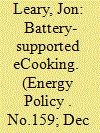

|
|
|
|
|
| Summary/Abstract |
Globally, 2.6 billion people still cook with biomass, resulting in interlinked health, environmental and drudgery challenges. The uptake of improved biomass cookstoves has barely kept up with population growth, yet SDG7 hopes for universal access to modern energy by 2030. This paper explores a potentially transformative new approach to facilitate access to affordable, reliable, sustainable and modern energy for cooking by leveraging rapid progress in electrification and falling prices of solar PV and lithium-ion batteries: battery-supported electric cooking. This paper presents empirical evidence on energy use, menu choices and cooking preferences from 83 households in 4 countries who transitioned from other fuels to electric cooking. A techno-economic model demonstrates that battery-supported electric cooking can be cost competitive with current expenditures on cooking fuels. No significant change in household menus occurred and the energy-efficient devices enabled 100% of everyday cooking with just 0.87–2.06 kWh/household/day. Our initial findings have already directly influenced the development of a 5-year UKAid-funded programme in collaboration with the World Bank, ‘Modern Energy Cooking Services’, and the new draft energy policy in Uganda. The paper concludes with two key policy recommendations: design lifeline tariffs inclusive of cooking and develop local markets for culturally-appropriate, quality-assured, energy-efficient cooking appliances.
|
|
|
|
|
|
|
|
|
|
|
|
|
|
|
|
| 4 |
ID:
175017
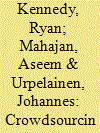

|
|
|
|
|
| Summary/Abstract |
Measuring energy access in developing countries involves much more than simply recording whether or not households are connected to the grid. Both international organizations and scholars now recognize the importance of reliable electricity supply for achieving positive development outcomes. Yet, measuring reliability is much more difficult than measuring the existence of connections. We propose an economical croudsourcing method for measuring reliability, and compare this method to energy monitor data for 122 households over 12 months. The results suggest that, while far from perfect, crowdsourcing provides a reasonably accurate method for monitoring the reliability of access over time, especially when modeled as a non-linear relationship. We apply these findings to model energy reliability in a broader group of villages across Uttar Pradesh, India, demonstrating the existence of disparities between urban and rural reliability and seasonal fluctuations in reliability. The system laid out in this study can be utilized by government and non-government organizations to quickly and cheaply monitor energy reliability.
|
|
|
|
|
|
|
|
|
|
|
|
|
|
|
|
| 5 |
ID:
098610


|
|
|
|
|
| Publication |
2010.
|
| Summary/Abstract |
Improving access to affordable modern energy is critical to improving living standards in the developing world. Rural households in India, in particular, are almost entirely reliant on traditional biomass for their basic cooking energy needs. This has adverse effects on their health and productivity, and also causes environmental degradation. This study presents a new generic modelling approach, with a focus on cooking fuel choices, and explores response strategies for energy poverty eradication in India. The modelling approach analyzes the determinants of fuel consumption choices for heterogeneous household groups, incorporating the effect of income distributions and traditionally more intangible factors such as preferences and private discount rates. The methodology is used to develop alternate future scenarios that explore how different policy mechanisms such as fuel subsidies and micro-financing can enhance the diffusion of modern, more efficient, energy sources in India.
|
|
|
|
|
|
|
|
|
|
|
|
|
|
|
|
| 6 |
ID:
192806
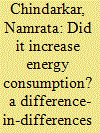

|
|
|
|
|
| Summary/Abstract |
Electricity access is an important issue and building capacity for it requires drawing relevant lessons from past policies. In this study, we evaluate the effect of the Jyotigram Yojana, or the lighted village scheme, a supply-side policy intervention during 2003–08 to increase rural electricity access in Gujarat, India. We hypothesize that policy implementation is associated with increased electricity consumption. To test this hypothesis, we exploit variation in the timing of policy implementation at the village level, and use a generalized difference-in-differences strategy for identification. Further, we use night-time luminosity measured through remote sensing as a proxy for electricity consumption, and control for weather, village fixed effect, year fixed effect, and village or administrative block specific time trend. We find that while the overall effect of the policy on night-time luminosity was not statistically significant, the effects were likely heterogeneous, with the night-time luminosity increasing in some districts after policy implementation and decreasing in others. We conclude that the policy might have had a re-distributive effect on electricity access or consumption and recommend adopting a more holistic approach – incorporating both supply-side and demand-side measures – to increase electricity access.
|
|
|
|
|
|
|
|
|
|
|
|
|
|
|
|
| 7 |
ID:
150911


|
|
|
|
|
| Summary/Abstract |
A majority of grid-connected households in South Africa use electricity for cooking and heating tasks. This thermal intensive use of electricity has a high load factor and is a contributory factor of electricity demand outstripping supply at peak demand periods. The government has promoted liquefied petroleum gas (LPG) as an alternative thermal energy source for household cooking and heating. This study evaluates the long-term successes, challenges and social impacts of an LPG intervention project that was piloted in Atteridgeville Township, a typical low-income suburb. The data was gathered through one-on-one household interviews with a sample of the beneficiaries. The results indicate that seven years after the LPG intervention, about 70% of the beneficiaries continue to use LPG and report that the intervention has improved their welfare. Fast cooking is cited as the key tangible benefit of LPG technology in households, followed by saving on electricity bills. The project would have achieved more success through better community engagement, including strict beneficiary selection criteria; a long-term LPG distribution and maintenance plan; and inclusion of recurring monthly LPG subsidies for indigent households. The study discusses the subset of factors necessary for successful rollouts of similar energy projects.
|
|
|
|
|
|
|
|
|
|
|
|
|
|
|
|
| 8 |
ID:
136232


|
|
|
|
|
| Summary/Abstract |
In Ethiopia biomass is predominantly utilized for household energy needs often using inefficient rudimentary stoves which cause adverse environmental and welfare effects. This paper examined the contribution of biomass resources to rural household energy use and energy substitution. The analysis applied the ordinary least square in the final stage estimation of fuelwood and overall biomass energy consumption by using predicted shadow prices. The paper used Tobit model to estimate charcoal and agricultural fuel consumption due to the presence of censoring. An increase in fuelwood shadow price was associated with reduced household fuelwood consumption with price elasticity of −0.38. The cross price elasticity between fuelwood and agricultural fuels revealed no evidence of energy substitution, which conforms to the findings of previous studies. Household access to electricity was associated with lower household biomass energy utilization but kerosene was not fuelwood substitute. Household energy use conformed to the ‘fuel stacking’ or ‘multiple fuel use’ concept, but households preferred modern energy options as welfare increased in areas where modern energy is available. This suggests that there is a promising prospect for fuel-transition, but access to modern energy and economic growth have key roles. The findings suggest that a concerted policy effort is required that would help diversify rural livelihoods, improve living standards and encourage economic growth, encourage inter-fuel substitution through improved modern energy access and afforestation to increase biomass supply.
|
|
|
|
|
|
|
|
|
|
|
|
|
|
|
|
| 9 |
ID:
168656
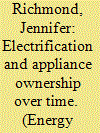

|
|
|
|
|
| Summary/Abstract |
Rural electrification has the potential to transform rural lives and livelihoods by allowing households to use a variety of electric appliances. However, empirical evidence on how rural electrification translates into appliance ownership and usage remains understudied across contexts. Here we use data from the 2014–2015 ACCESS survey in six energy-poor states of India to understand the dynamics of appliance stock accumulation as a function of time since electrification. We find that, controlling for a number of variables, each additional year of electricity access leads to: 1) incrementally higher ownership rates of more power-intensive appliances, 2) increased likelihood of a higher total stock of appliances, and 3) increased probability of owning key appliances, especially TVs, fans, and pressure cookers. These results may help to explain why short-term impact evaluations sometimes find weak evidence for benefits of rural electrification; they also underscore the importance of realistic forecasts of energy demand growth over time after rural electrification.
|
|
|
|
|
|
|
|
|
|
|
|
|
|
|
|
| 10 |
ID:
180096
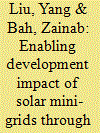

|
|
|
|
|
| Summary/Abstract |
Renewable energy based mini-grids offer a critical solution for universal access to energy in sub-Saharan Africa. We conduct a survey in rural Sierra Leone to measure the perception of local beneficiaries of two solar mini-grid projects vis-à-vis renewable energy potential, community engagement and poverty alleviation. By applying a simple mediation model, we find that the community engagement plays a significant role of chain of influence between renewable energy and poverty reduction - each 1% increase in the perceived renewable energy potential can lead to a 0.195% increase in the perceived poverty reduction, resulting from the community engagement. This mediating effect of the community engagement accounts for around 60% of the total effects of renewable energy on poverty reduction. These findings suggest that empowering the community is essential to creating electricity demand and delivering development impact of renewable energy based mini-grids in the deep poverty context.
|
|
|
|
|
|
|
|
|
|
|
|
|
|
|
|
| 11 |
ID:
113490


|
|
|
|
|
| Publication |
2012.
|
| Summary/Abstract |
After decades of research on the subject of energy poverty and access and its impact on human development, the issue has finally gained global attention and commitment through the UN Secretary General's initiative on Sustainable Energy for All. However, the issue of what constitutes energy access and how such access can be supported by efficient subsidies remains a key question that does not have simple answers. At what point along the energy consumption and income spectrum does the energy access problem cease to be one of public policy, thereby letting the market take over? Using data from an extensive survey carried out by the Government of India, this paper highlights the complexities and inadequacies of using a normative consumption based approach to determine the scope and scale of interventions required. Factoring in the environmental and social pillars of sustainable development when defining access to modern energy forms would also significantly inform the level of effort involved in meeting the goal of energy access to all.
|
|
|
|
|
|
|
|
|
|
|
|
|
|
|
|
| 12 |
ID:
125619


|
|
|
|
|
| Publication |
2013.
|
| Summary/Abstract |
Energy access has been singled out by the AGECC in 2010 as one of the important problems to be tackled in the next few decades in a world where 1.3 billion people do not have access to electricity and 2.7 use primitive fuels - mainly fuel wood - for cooking and heating.
To solve such problems, innumerous small scale projects have been implemented around the world either on the improvement of cooking stoves, biogas and others, as well as in generating electricity in decentralized systems.
We discuss here the "large scale approach" to solve these problems in Brazil through the introduction of LPG (liquid petroleum gas) in Brazil 70 years ago, all over the country, as a cooking fuel that replaced significantly the use of fuel wood in rural areas. In addition to that, we describe the governmental program (Luz para Todos - LPT - Light for all) introduced more recently to extend the electricity grid to around 10 million people, reducing considerably the number of people without access to electricity in the rural areas of the country.
Such experiences and the corresponding lessons learned could be replicated in other developing countries, contributing significantly to poverty alleviation.
|
|
|
|
|
|
|
|
|
|
|
|
|
|
|
|
| 13 |
ID:
094913
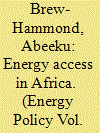

|
|
|
|
|
| Publication |
2010.
|
| Summary/Abstract |
This paper presents a review of the current situation and projections for energy access in Africa. The paper also presents several sets of ambitious energy access targets as agreed by the regional groupings within the region. The paper argues that achieving between 50% and 100% access to modern energy services by 2030 in Africa will require more effective mobilization and use of both domestic and external funding, and the development and implementation of innovative policy frameworks. The paper suggests that greater emphasis will need to be placed on productive uses of energy and energy for income generation in order to break the vicious circle of low incomes leading to poor access to modern energy services, which in turn puts severe limitations on the ability to generate higher incomes. The paper further suggests that if anything near the ambitious targets set by African organisations are to be achieved then it will be advisable to tap into the full menu of energy resource and technology options, and there will be the need for significant increases in the numbers of various actors involved together with more effective institutions in the energy sector.
|
|
|
|
|
|
|
|
|
|
|
|
|
|
|
|
| 14 |
ID:
169724
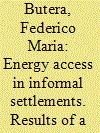

|
|
|
|
|
| Summary/Abstract |
This paper presents the results of a survey on two informal settlements in Rio De Janeiro: Reta Velha (Itaboraí) and Jardim Bom Retiro (São Gonçalo). A detailed analysis of energy access and energy poverty level has been accomplished by questionnaires carried out in 400 households. The questionnaire was based on a detailed multi-tier approach. It was aimed at exploring the actual energy access and energy poverty in favelas, in addition to draw the local living conditions and the availability of the basic services. The outcomes of the research underline the problem of outages and low tension, and illegal connections. Furthermore, electricity consumption is very high compared to the service provided, and expenditures are generally disproportioned to the households’ income. Many interesting outcomes emerge from the survey. Referring to energy poverty, it is a status in which 50% of households are in Jardim Bom Retiro and 20% in Reta Velha. Due to the representativeness of the treated case, the results permit the definition of the state of the art and of enhancing guidelines suitable also for other contexts, at least in the universe of informal settlements in Latin America and Caribbean.
|
|
|
|
|
|
|
|
|
|
|
|
|
|
|
|
| 15 |
ID:
177404


|
|
|
|
|
| Summary/Abstract |
Using unique household-level data from rural areas of six energy-access-deprived states in India, we examine the willingness-to-pay (WTP) for exclusive use of liquefied petroleum gas (LPG) for cooking. We find that awareness about LPG's health benefits and diffusion of LPG within the community are the strongest determinants of WTP for exclusive use of LPG. Among demographic characteristics, only household size is correlated with WTP. Importantly, households exhibit significant price elasticity with regards to exclusive use of LPG. Households with irregular cash flows are less likely to pay for exclusive use of LPG. We find limited evidence supporting a negative association between availability of free biomass and the WTP for exclusive use of LPG. In contrast, higher household expenditure on purchased biomass is positively associated with WTP. Our estimates of mean WTP suggest that they are higher than the current effective monthly cost of subsidized LPG across households. However, they mask variation, and disaggregated estimates suggest that about 40–45 per cent of the households not using LPG as their primary fuel have a lower WTP than the current effective monthly cost of subsidized LPG and hence would need additional support to enable their cooking energy transition.
|
|
|
|
|
|
|
|
|
|
|
|
|
|
|
|
| 16 |
ID:
175241
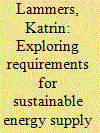

|
|
|
|
|
| Summary/Abstract |
Southeast Asia is one of the regions most affected by impacts of climate change underlying the urgency to build resilience especially for remote and isolated island communities. Moreover, these islands face the problem of expensive and unreliable electricity supply. The large number of island communities further magnifies the difficulty of reaching universal sustainable electricity supply. Off-grid electrification technologies promise to tackle this challenge entailing high investments yet also market potential. Currently both aspects – electricity access and climate resilience - are barely linked in electrification planning. Energy planning in a region highly affected by climate change requires integrative planning considering these risks. Here, to enhance integrative planning, we study the status quo of energy access and risk exposure of non-electrified Southeast Asian islands. We identify 1932 islands with a population greater than 21 million having limited access to electricity. Our study reveals three risk-specific island archetypes, which need different technical measures to enhance climate resiliency of future electricity systems. We conclude that future energy planning in Southeast Asia requires climate resilience as an additional planning dimension. The identified cluster groups serve as a blueprint for decision makers to support measures improving energy systems’ resilience avoiding expensive re-investments in the future.
|
|
|
|
|
|
|
|
|
|
|
|
|
|
|
|
| 17 |
ID:
192727
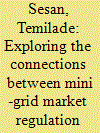

|
|
|
|
|
| Summary/Abstract |
About 140 million people across Africa are expected to gain access to electricity from mini grids by 2040. Nigeria, with the least dependable electricity supply on the continent, stands to benefit significantly from this boon. Accordingly, the government has put in place clear regulations to incentivise private investment and drive market growth. While the techno-economic dimensions of the growing mini-grid sector and the broader electricity industry have been extensively studied, less attention has been paid to analysing the impacts of the regulatory framework on the achievement of rural electrification and universal energy access goals. Drawing on qualitative data obtained from key regulatory and market actors in the Nigerian mini-grid sector, this paper interrogates the premise of pursuing widespread rural electrification through a regulatory framework that is primarily geared toward increasing market efficiency. The study finds that, while the current framework has enabled growth in the sector, complementary mechanisms are required to achieve equitable distribution of access, especially among the mainly rural populations dwelling on the fringes of mainstream electricity markets. The findings are instructive for practitioners and policy makers seeking evidence-informed approaches to achieving the goal of universal energy access in Africa.
|
|
|
|
|
|
|
|
|
|
|
|
|
|
|
|
| 18 |
ID:
162968
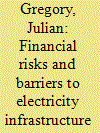

|
|
|
|
|
| Summary/Abstract |
The recent academic literature contains a number of hypotheses, drivers, or explanations to reveal why electricity infrastructure isn’t being developed within sub-Saharan Africa (SSA) in the 21st century. In this paper, we argue that this literature is misdirected, or at least incomplete, in how it approaches risk. We hypothesise that this lack of infrastructure development in the region reflects a dearth of investment due to the existence of excessive negative uncertainties or risks – as investment is a function of uncertainty and reward – but that the recent academic literature appears to not appreciate this. To make this argument, we chose a manageable sample of three African countries, which already had a notable body of academic literature concerning them: Kenya, Mozambique and Tanzania. Focusing on these countries, we then undertook a systematic review of 815 ‘peer reviewed’ papers published on the academic libraries of Scopus and/or the Web of Science on the topic of electricity, infrastructure, and risk over a five-year period to see how this literature evaluated the problem. Drawing from the most relevant 101 studies within that sample, we critically examine the methodological, conceptual, and empirical aspects of this literature.
|
|
|
|
|
|
|
|
|
|
|
|
|
|
|
|
| 19 |
ID:
113497


|
|
|
|
|
| Publication |
2012.
|
| Summary/Abstract |
Modern energy access in Africa is critical to meeting a wide range of developmental challenges including poverty reduction and the Millennium Development Goals (MDGs). Despite having a huge amount and variety of energy resources, modern energy access in the continent is abysmal, especially Sub-Saharan Africa. Only about 31% of the Sub-Saharan African population have access to electricity while traditional biomass energy accounts for over 80% of energy consumption in many Sub-Saharan African countries. With energy use per capita among the lowest in the world, there is no doubt that Africa will need to increase its energy consumption to drive economic growth and human development. Africa also faces a severe threat from global climate change with vulnerabilities in several key areas or sectors in the continent including agriculture, water supply, energy, etc. Low carbon development provides opportunities for African countries to improve and expand access to modern energy services while also building low-emission and climate-resilient economies. However, access to finance from different sources will be critical in achieving these objectives. This paper sets out to explore the financial instruments available for low carbon energy access in Africa including the opportunities, markets and risks in low carbon energy investments in the continent.
|
|
|
|
|
|
|
|
|
|
|
|
|
|
|
|
| 20 |
ID:
113410
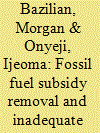

|
|
|
|
|
| Publication |
2012.
|
| Summary/Abstract |
We briefly consider the impact of fossil fuel subsidy removal policies in the context of inadequate power supply, with a focus on the implications for businesses. In doing so, we utilize the case of the early 2012 fuel subsidy removal in Nigeria. The rationale for such subsidy-removal policies is typically informed by analysis showing that they lead to an economically inefficient allocation of resources and market distortions, while often failing to meet intended objectives. However, often the realities of infrastructural and institutional deficiencies are not appropriately factored into the decision-making process. Businesses in many developing countries, already impaired by the high cost of power supply deficiencies, become even less competitive on an unsubsidized basis. We find that justifications for removal often do not adequately reflect the specific environments of developing country economies, resulting in poor recommendations - or ineffective policy.
|
|
|
|
|
|
|
|
|
|
|
|
|
|
|
|
|
|
|
|
|